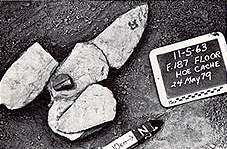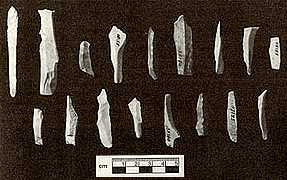
Cache of mill creek chert hoes.

Chert microdrills.

Cache of mill creek chert hoes. 
Chert microdrills.
|
Archaeological evidence for the transformation of a food surplus into less
perishable material wealth in this local economic sphere is abundant. Found in
the smaller sites of Mississippian farmers (farmsteads and hamlets) are caches
of Mill Creek Chert hoes, microdrills (the tools for the manufacture of shell ornaments), marine and
freshwater shell beads, and shell debris. This evidence for the manufacture of
decorative objects for commoner's personal consumption speaks both of the
economic ability to acquire valued material, marine shell for example, as well
as the spare time to increase the worth of the material by converting it into
decorative objects. Specialized structures such as stone lined storage pits,
and large sweatlodges also suggest that food abundance was translated into
labor for special projects and activities that benefited and served the
community.
|